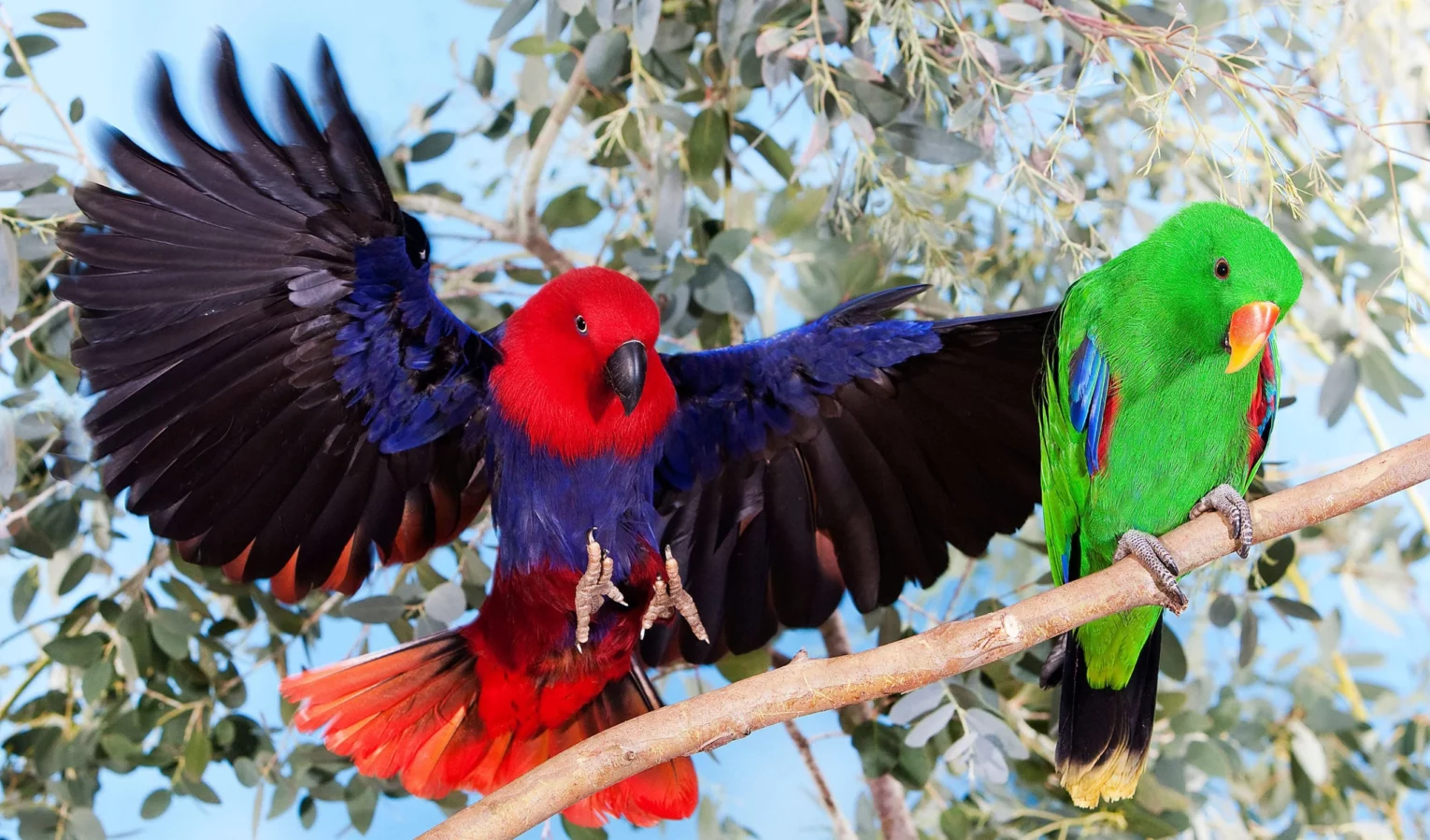
Scientific Name: Eclectus roratus
Description:
- Appearance: The Eclectus Parrot is renowned for its striking sexual dimorphism. Males are bright green with varying splashes of red and blue on their wings and tail, and an orange beak. Females, on the other hand, are predominantly red with blue and purple hues and sport a black beak.
- Size: These birds are medium-sized, typically ranging from 17 to 20 inches (43 to 50 cm) in length.
- Sexual Dimorphism: The Eclectus is one of the few parrot species where males and females are visually distinct.
Lifespan:
- In captivity, Eclectus Parrots can live for 30 to 50 years, sometimes longer with optimal care.
Habitat:
- Natural Habitat: Originally from the rainforests of the Solomon Islands, New Guinea, northeastern Australia, and the Maluku Islands (Moluccas).
- In Captivity: They need large cages or aviaries that provide ample space for movement and exercise. They also benefit from a safe, bird-proof area outside the cage where they can interact with their environment.
Behavior:
- Temperament: Known for their calm and gentle nature, they can be very affectionate and sociable with their human families.
- Vocalization: They are relatively quieter compared to other parrot species, but they can mimic words and sounds.
- Interaction Needs: They thrive on social interaction and require regular engagement with their human companions.
Diet:
- In the Wild: Their diet mainly consists of fruits, nuts, seeds, and nectar.
- In Captivity: A diet rich in fruits and vegetables is essential. High-quality pellets and a moderate amount of seeds can be included. Avoid avocado and chocolate.
Health Care:
- Veterinary Check-ups: Regular visits to an avian vet are important. They can be prone to vitamin A deficiency and feather picking if their nutritional and emotional needs are not met.
- Signs of Illness: Watch for changes in eating habits, feather condition, behavior, and droppings.
Breeding:
- Breeding in Captivity: Requires a deep understanding of their needs and a commitment to providing ongoing care for both parents and chicks.
- Clutch Size: Typically, the female lays 2 eggs per clutch.
Conservation Status:
- While not currently endangered, habitat loss and the pet trade are concerns. Conservation efforts are important to sustain their wild populations.
Tips for Potential Owners:
- Understanding Their Needs: They require a balanced diet and plenty of social interaction.
- Noise Level: They are less noisy but still vocal, suitable for owners who prefer quieter birds.
- Long-Term Commitment: Their long lifespan means owning an Eclectus is a long-term commitment that should be considered carefully.
Conclusion: The Eclectus Parrot, with its distinctive appearance and gentle temperament, makes a wonderful pet for those who can meet its specific dietary and social needs. They require committed owners who understand the importance of a balanced diet and can provide ample social interaction and mental stimulation. With the right care, an Eclectus Parrot can be a delightful and affectionate companion for many years.
What makes Eclectus Parrots unique compared to other parrots?
- Their most striking feature is the vivid sexual dimorphism: males are bright green, while females are mostly red and blue. They are also known for their calm demeanor and relatively quiet nature compared to other parrot species.
Can Eclectus Parrots talk or mimic sounds?
- Yes, they are capable of mimicking human speech and sounds. While not as prolific as some other parrot species, they can learn a variety of words and phrases.
What diet is best for an Eclectus Parrot?
- They require a diet rich in fresh fruits and vegetables. High-quality pellets and a moderate amount of seeds can be included, but their unique digestive system means they benefit from less protein and more fiber. Avoid avocado and chocolate as they are toxic to birds.
How much interaction do Eclectus Parrots need?
- They are social birds and require significant daily interaction with their owners. They thrive on attention and can become depressed or exhibit behavioral issues if neglected.
Are Eclectus Parrots good for first-time bird owners?
- While they are gentle and affectionate, their specific dietary and social needs might be challenging for first-time bird owners. Prospective owners should thoroughly research and ensure they can commit to their care.
How can I tell if my Eclectus Parrot is healthy?
- Signs of a healthy Eclectus include bright, clear eyes, clean and well-preened feathers, active behavior, and a good appetite. Regular check-ups with an avian veterinarian are essential.
Do Eclectus Parrots require a special type of cage?
- They need a large cage that allows them to move freely, stretch their wings, and play. The cage should be equipped with toys, perches, and foraging opportunities to keep them mentally stimulated.
What are common health issues in Eclectus Parrots?
- Common issues include vitamin A deficiency, feather picking (often due to dietary imbalances or stress), and respiratory problems. A balanced diet and a stress-free environment are key to prevention.
How do Eclectus Parrots generally interact with children and other pets?
- They are generally gentle and can coexist with children and other pets if properly socialized and supervised. However, interactions should always be monitored to ensure safety for both the bird and others.
Is it difficult to train an Eclectus Parrot?
- They are intelligent and can be trained using positive reinforcement techniques. Patience and consistency are important, as is starting training at a young age if possible.
These FAQs cover essential aspects of Eclectus Parrot care, behavior, and needs, helping potential and current owners understand how to provide the best care for these unique and captivating birds.
